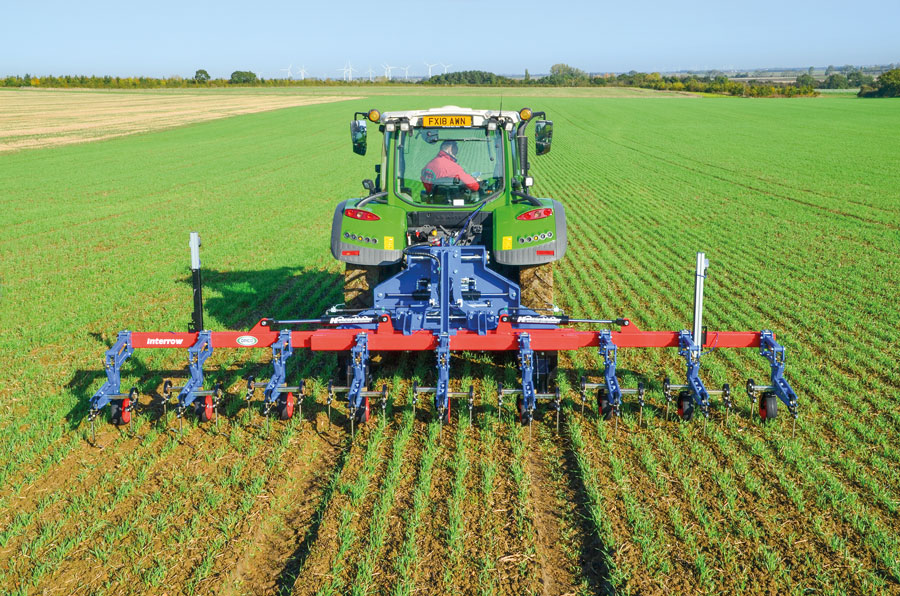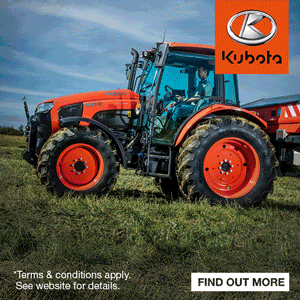Chemical-free precision weed control
22nd November 2019
A new mechanical weed control option has been added to Opico’s line-up, and is expected to appeal to a wide variety of users. David Williams was at the press launch.

A new mechanical weed control option has been added to Opico’s line-up, and is expected to appeal to a wide variety of users. David Williams was at the press launch.
Weed removal by hoeing was common practice until selective herbicides became available, but a reduced chemical armoury and increased chemical resistance, particularly in grass weeds such as black-grass, has renewed interest in the technique. Also creating additional demand for mechanical weed control are major buyers such as supermarkets, keen to supply food which has had less chemical exposure. For organic food production, which relies on mechanical and cultural weed control, hoeing remains essential to growing clean crops.
Mechanical hoeing provides many advantages over chemicals, but a disadvantage for large-scale farms has been the slower work rates needed to guide hoe bodies within just a few millimetres of growing crops. But, increased use of precision guidance and automatic steering has meant tractors can be relied upon to maintain an accurate track, so that mounted implements travel precisely. This has increased travel speeds, boosting work rates and increasing acceptability.
Opico offers a wide range of machinery through an excellent UK dealer network and adding a range of mechanical hoes to complement its current Comb Harrows will be popular with distributors and customers. Its new inter-row cultivators are manufactured by Austrian specialist Hatzenbichler, which has supplied harrows to Opico since 1994.
“The build quality is excellent,” explained Opico managing director, James Woolway. “There are several unique design features offering significant advantages for users.”
The Hatzenbichler family has farmed since the 1930s, and commenced implement manufacturing in 1952 when it produced its first mechanical weeder in the form of the Comb Harrow – the first of its type to enter production, and the predecessor to more than 7,000 units sold by Opico. A few years later it added inter-row cultivators to its range. The family switched to organic crop production on their farm in 1995 and the experience gained in finding solutions for their own crops contributes to product development.
Growing demand
“UK demand for Comb Harrows is mainly for organic farms,” explained James, “but we also supply them to some conventionally run farms and vegetable producers, particularly in recent years as supermarkets specify crops produced with fewer chemicals. We have seen growing interest in inter-row cultivation from all these sectors recently.
“We are also experiencing demand for mechanical weeding and inter-row crop establishment from maize growers, particularly where post-harvest soil run-off is an issue. This is certainly a market where interest will increase.”
James commented that potatoes are also a potential market for the technology due to the expectation that buyers will demand reduced chemical exposure in future, and he believes conventional arable crops will come under tighter scrutiny too, in terms of their environmental footprint.
Will it work?
Successful mechanical weed control depends on multiple factors, explained James, adding that it’s best to cultivate soil prior to crop establishment. Incorporating the technique into plough-based or min-till cultivation systems isn’t an issue, but it cannot be used in 100 per cent no-till establishment regimes unless crop residues are removed and the soil is easily worked.
Row widths have to be considered for inter-row cultivations and, while it is possible to mechanically weed between 12.5cm rows this might not allow the best weed control, depending on the crop and variety, if plants meet across the rows during the season. Wider row widths similar to those used in organic systems may become more popular as the inter-row technique is adopted on conventional farms. Weed emergence periods have to be considered in relation to weather conditions and crop development.
While inter-row cultivators tend to be used later in the growing season, comb weeders are used prior to establishment and through earlier stages of crop development. Stale seedbed combing is often used to remove weeds prior to drilling in the same way cultivation and chemicals are used. When weeding in the crop, multiple high speed passes of a comb harrow are used to control secondary weed growth resulting from seed germination encouraged by the first weeding pass.
The critical weed-free period for each crop – during which weed development could reduce yields – also needs consideration to make sure cultivation can provide control when needed.
James suggested that a hybrid system is attractive, combining mechanical with chemical weed control, offering advantages including reduced chemical reliance and lower production costs.
Opico is promoting both its Comb Harrow and inter-row cultivators as potential solutions for arable weed control.
Unlike the inter-row cultivators which cultivate aggressively between crop rows, the Comb Harrow is indiscriminate – raking across its full working width. Three gauges of rake steel are available, applying varying flexibility and working pressure. The thinnest 6mm is selected for vegetables and salad crops; 7mm is usually chosen for broad acre arable crops and 8mm, for the most aggressive raking, is used on grassland. The Hatzenbichler harrow has 30mm tine spacing and the raking action and sprung steel tines create the oscillation necessary to cover the entire surface.
A suitable tine angle is essential for optimum weed removal without crop damage, and Hatzenbichler comb harrows are supplied with manual or hydraulic rake angle adjustment in 10 stages. James stressed that this variation of pressure is needed, and to obtain best results it will typically be adjusted several times per day as the soil dries out or to suit different soil types.
Rakes are mounted in working sections which move and twist for accurate contour following. The main frame, along which the sections are mounted, is also capable of flexing to accommodate undulating field surfaces.
“The combing technique relies on crop roots being stronger than the weeds to withstand the raking action,” explained James. “As soon as the weed root is as big as the crop roots it’s too late, so subsequent passes to tackle new weed growth need to be while weeds are small. The Comb Harrow leaves a level surface and breaks up any capping, improving water infiltration and root zone air interchange. The raking action also stimulates tillering and releases surface nitrogen, so rather than damaging the crop, opportunities for higher yields are increased.”
Most Comb Harrows supplied by Opico are fitted with mounted seed/fertiliser applicators which make them very versatile. Demand for re-seeding grassland continues, but for arable farms the opportunity to cheaply establish cover crops is attractive.
Inter-row cultivators
The new inter-row cultivators accurately till between rows of growing crops to cut off the weeds just below the surface. They are fully adjustable and can be configured for any row width or combination of row widths. The line-up includes models from 2.5–18m working width to cultivate up to 72 rows in one pass. Front- or rear-mounted versions are available, along with trailed semi-mounted models, and although historically demand was for front-mounting for easier monitoring from the tractor seat, now rear-mounted are more popular as auto-steer systems require less operator input. Extra precision is also available through integral camera-controlled steering systems, mounted on the cultivator itself.
For automatic row following, Opico has teamed up with camera manufacturer Tillet & Hague, which develops and manufactures systems in the UK. Up to eight cameras can be mounted on each machine and the system combines the information provided and makes judgements regarding the optimum strategy, which is especially useful for complex headlands or where there are gaps in the crop. The cameras not only register the row position, but also calculate travel speed, so separate speed monitoring isn’t required. A minimum of two cameras are recommended, and the user can select which camera’s information should be used in advance, such as when approaching diagonal headlands.
Tillet & Hague’s software also allows for the addition of spot spraying technology on the cultivator.
The hoes mount on a guidance headstock from which the relative working position is varied by a double-acting, double-rod hydraulic cylinder. A potentiometer monitors movement to ensure precise positioning. Up to 250mm each side of centre is available, allowing accurate compensation for deviations caused by side-slopes, as well as errors due to drilling off-centre to the tramlines.
Moving the hoes sideways to follow plant rows creates powerful lateral forces. This is particularly the case with wider working widths, or when the tines are working deep. The tubular mounting frame is manufactured with a bespoke profile used by Hatzenbichler for more than 30 years. Each parallelogram unit clamps to the tube using a simple but positive mounting system which prevents unwanted movement, but allows easy adjustment of the mounting position for different row configurations.
If side forces exceed grip from the tractor’s rear wheels, then the tractor could be moved sideways leaving the hoe position unchanged and resulting in crop damage. To prevent this, Opico’s hoe has a pair of large diameter flanged steel wheels, which anchor the guidance headstock in line behind the tractor wheels for perfect row following.
Optimum results
The hoe carriers’ parallelogram mounting frames maintain pre-set working angles and pressure, while allowing accurate ground contour following. Different numbers of tines are fitted to the carriers, depending on row widths and crop types. For example; in cereals three rows are hoed per carrier with a minimum row spacing of 12.5cm.
All models fold for transport to under 3m and folded height is below 4m.
Vibro-tines with Duck’s foot shares penetrate hard dry ground, cutting weeds off below the surface without excessive soil movement.
Section control is an option expected to appeal to UK users. The Muller system provides automatic control of up to 13 sections which lift hydraulically as they reach the headland rows. This offers particular advantages for irregular fields where diagonal joints feature between the main field and headland. The biggest benefits are for wider working widths, where operation without section control would mean either missing triangular areas at the beginning or end of each bout, or destruction of some of the crop.
Tine options include S-tines or Vibro-tines fitted with either Duck’s foot or A-shares and, with endless adjustment available, almost any crops with adequate space between the rows can be tackled.
Adding a mounted applicator provides opportunities to apply nutrients precisely, or to under-sow or strip-seed additional crops through coulters or by broadcasting. “This is particularly beneficial where wide 75cm maize rows are used, as targeted application of fertiliser to the plant base avoids waste and reduces risk of run-off,” added James.
Further options include Kress finger weeders consisting of plastic-spoked discs operating at an inclined angle below plant foliage, and crop protection discs to reduce soil throw onto young plants.
Combined solution
Adding inter-row cultivators to Opico’s product offering is likely to prove a good move by the importer. The long-established relationship with Hatzenbichler means those investing in the products are assured of great back-up, including expert advice as to the best solution for their needs. Combining the benefits of a comb harrow and an inter-row cultivator makes sense, offering solutions for growing crops throughout the season, and additional options such as precision fertiliser placement and inter-row seeding adds possibilities for the future.
Prices for a 6m, 12-row inter-row cultivator suitable for sugar beet start at £19,851, and a 6m, eight-row version set up for maize is £21,458. A guidance headstock with a quick-hitching feature adds £28,405, and a seeder and platform adds a further £8,674.


